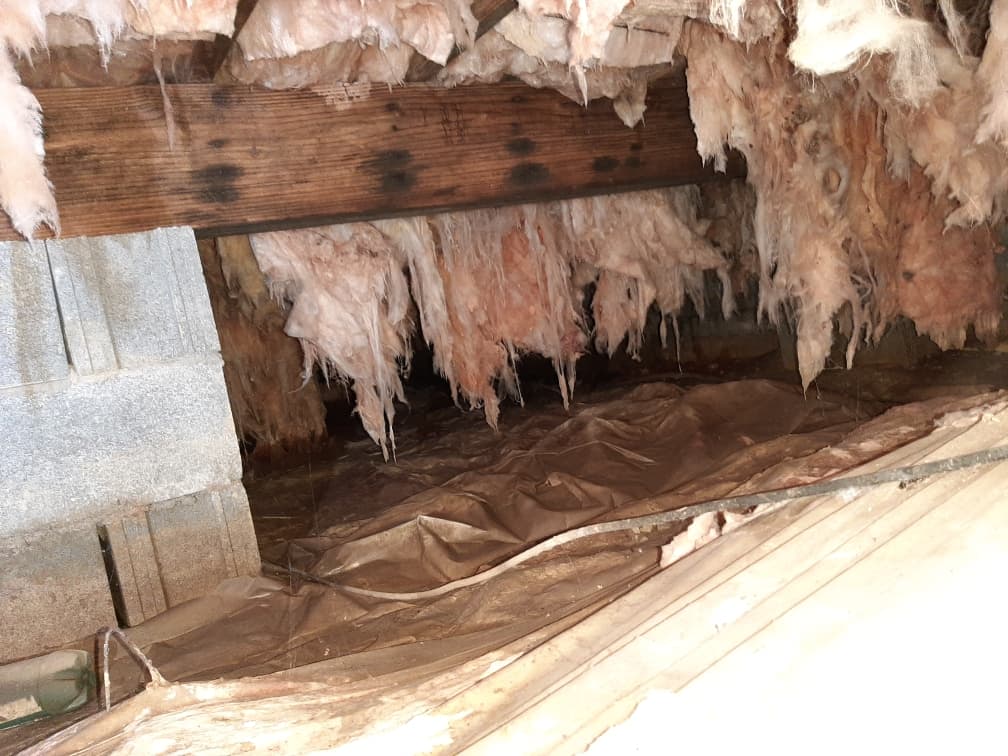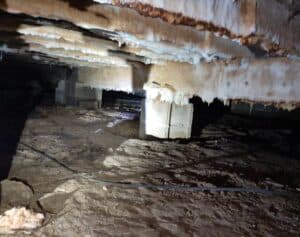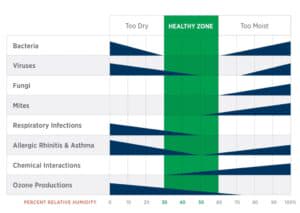Repairing Your Crawl Space

Originally posted 3/18/19, revised 8/11/21
People don’t hang out in their crawl spaces. In fact, most homeowners never go into that dark and cramped area at all! And who could blame you? At best, your crawl space is unlit, dirty, and home to spiders and other insects. The only person who wants to be in a place like that is my slightly crazy niece, who actually likes spiders (yes, she’s an entomologist).
At Acculevel, we’re not big fans of spiders, but we don’t let them stop us from taking care of our customers. Since our start in 1996, Andy Beery’s family-owned and operated has helped over 30,000 homeowners regain health, security, and stability in their homes. We know that the odors, humidity, and other unsavory things that thrive in your crawl space have a direct and negative impact on your home’s air quality and your health.
In this article, we’re going to discuss three major issues that damage your crawl space, how they can be treated, and why you need to have a professional contractor make these repairs.
Strong Musty Odors
If your crawl space smells like a funky gym bag, this is not normal. In all honesty, it should smell like earth- if it has any smell at all. This is because there’s no floor installed below your home; the crawl space is open to the dirt below it.
Some odors emanate from the ground itself. These can be harmless, but that doesn’t make them smell pleasant. To counter this, you should have a good vapor barrier installed. Ideally, you should have your crawl space encapsulated; a vapor barrier is the minimum you should invest in.
Another possibility is that biological growth is developing in your crawl space. Nasty organisms like mold and mildew don’t need a lot of encouragement to grow: a little dust or particles to feed on and some moisture is enough. The odors and spores that come from these biological growths can be a significant health hazard. If you think there may be a mold or similar invasive growth in your crawl space, you should have this evaluated by a professional at once, to reduce exposure for you and your family.
 This photo was taken by an Acculevel project advisor during a free estimate appointment. The floor joists and beams are heavily covered with mold.
This photo was taken by an Acculevel project advisor during a free estimate appointment. The floor joists and beams are heavily covered with mold.
HVAC Inefficiency
Have you noticed your floors being colder in the winter? Or is it more humid and clammy in the summer? Review your utility costs for the last year or so, and compare not just costs, but usage. Is your HVAC running more frequently, but not keeping you more comfortable? Then it’s time to assess your home for possible issues.
Many homes were built with fiberglass insulation installed in their crawl spaces. Given what we know now, you would be better off with NO insulation than with fiberglass insulation between your floor joists. Fiberglass insulation absorbs moisture. Placing moisture directly against wooden floor components like joists and beams is the easiest way to make wood rot. Decaying wood flooring structure is the primary reason floors sag.
In short, removing fiberglass insulation and replacing it with spray foam is one of the best home investments you can make. Spray foam conforms exactly to each space, blocks even the smallest gap, and repels water. It provides a much higher R value than failing fiberglass insulation, and won’t lead to floor damage.
 This photo was taken by an Acculevel project advisor, during a free estimate appointment. The fiberglass insulation has gotten damp, and is falling down from the added weight of moisture.
This photo was taken by an Acculevel project advisor, during a free estimate appointment. The fiberglass insulation has gotten damp, and is falling down from the added weight of moisture.
Another way to improve your HVAC efficiency -and dramatically improve your air quality- is to install a whole-home dehumidifier. A dehumidifier removes moisture from the air, right? We all know that. But were you aware that air at the optimum relative humidity level is healthier for you?
 Information taken from a study performed by ASHRAE (the American Society of Heating, Refrigerating and Air-Conditioning Engineers.)
Information taken from a study performed by ASHRAE (the American Society of Heating, Refrigerating and Air-Conditioning Engineers.)
By keeping your home at a 50% humidity level, a dehumidifier can prevent most bacteria, fungi, viruses, allergens and respiratory germs from reproducing or growing. It will also reduce the workload for your HVAC system, because drier air is easier to process, whether it’s cooling or heating.
Moisture or Signs of Water
We mentioned how moisture can damage your wooden flooring components, and how it helps make your crawl space inhabitable for biological growths. But having water in your crawl space, especially if it’s close to the walls, also harms the foundation of your home. Water can erode the ground beneath the foundation, causing it to settle unevenly. It can also put pressure (known as hydrostatic pressure) against the foundation walls, creating cracks or bowing.
If you live in an area where the water table is high, or you have other indicators like odors and dampness, water drainage may be the best way to protect your home’s foundation.
Since a crawl space doesn’t have a concrete floor, you’ll need to have a specialized drainage system installed. Acculevel installs GeoChannel in crawl spaces, because it is designed specifically to filter out all the dirt and debris common to a dirt floor.
 This photo was taken by an Acculevel crew member during water drainage installation. The GeoChannel is buried next to the interior wall, to collect and move the water to a sump pump.
This photo was taken by an Acculevel crew member during water drainage installation. The GeoChannel is buried next to the interior wall, to collect and move the water to a sump pump.
In the above photo, you can also see that weep holes have been drilled into the bottom row of blocks. This ensures that any water that collects inside the walls has an efficient way to drain out. Remember, concrete is porous- so any water collecting against your foundation can (and will!) seep in.
If you haven’t ever been in your crawl space, you probably don’t know if there’s water in it. But a quality contractor will be able to detect various signs (like water lines or efflorescence) that show if water intrusion has previously been an issue.
Do You Need a Contractor to Repair Your Crawl Space?
It’s important that you find a repair company that is a good fit for you. Often, the best way to find a good contractor is to ask friends or neighbors who have had similar services done. If you’re new to the area, or all your friends have slab foundations, check with your HOA or the realtor that sold your home.
Even if a company gets stellar reviews, you should verify that they are also insured and accredited by the Better Business Bureau. We have a free resource that you are welcome to use: it’s our guide to Questions to Ask a Contractor. This article provides Acculevel’s answers, and explains why we believe each question is relevant and necessary.
If you live in Indiana or the surrounding areas (we have recently expanded to include Cincinnati, OH!), contact us by phone at 866-669-3349 or by filling out our estimate form. We will schedule an appointment for you with one of our expert project advisors. They will arrive on time, listen to your concerns, and thoroughly evaluate your home. Our goals are to treat your home as if it were our own, develop a whole-home solution, and provide 5 star customer service every step of the way.